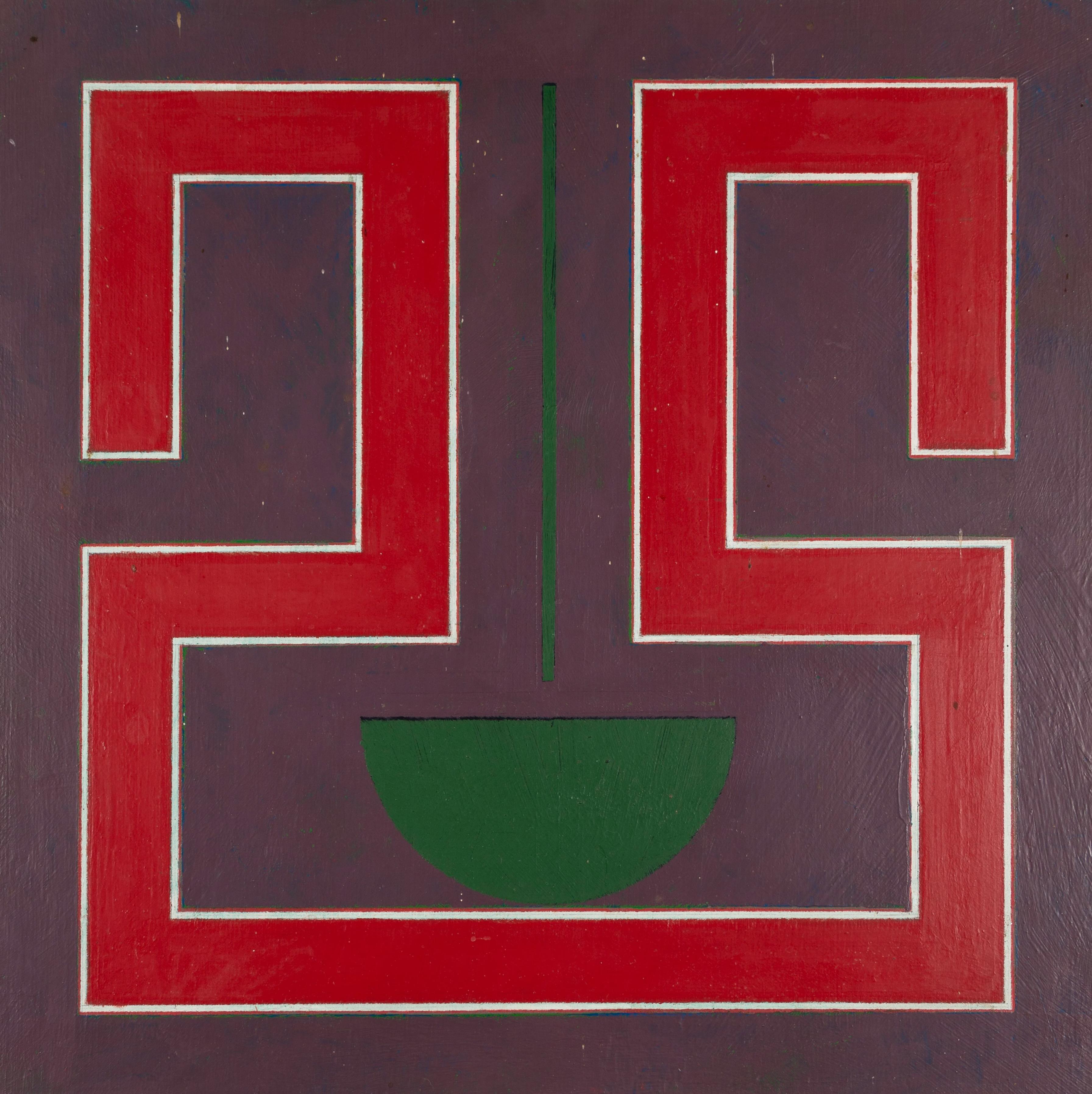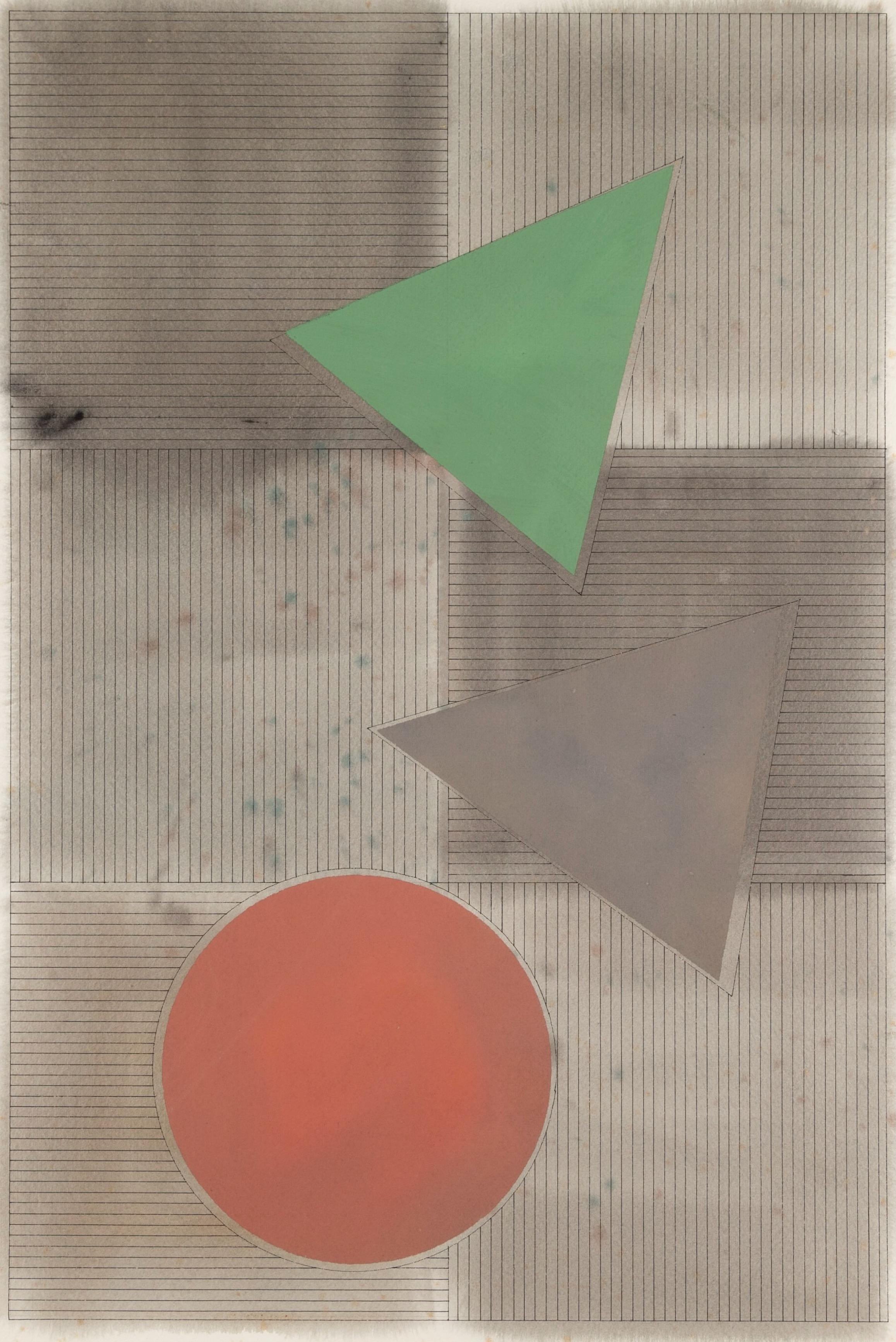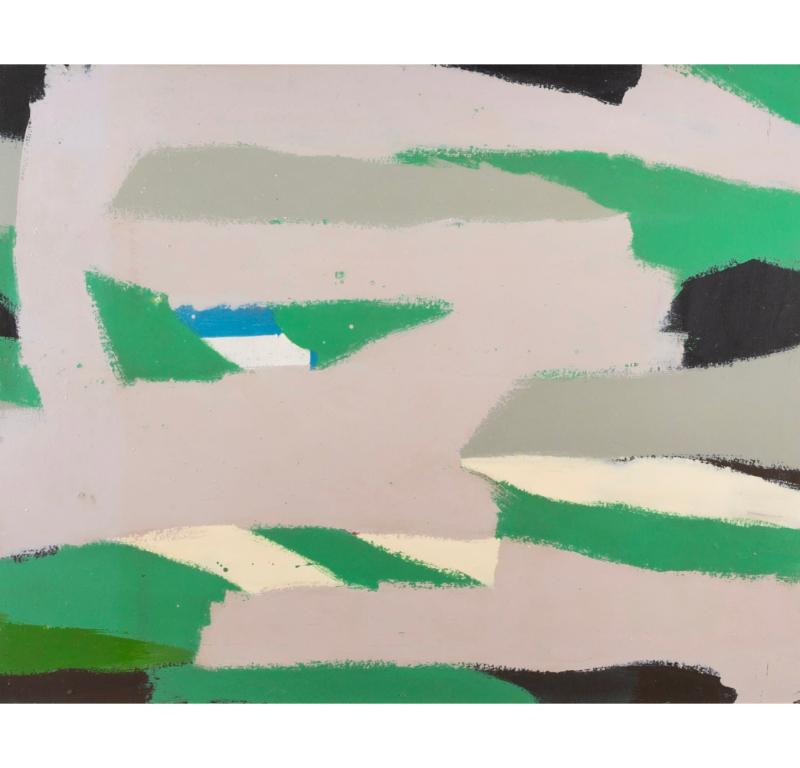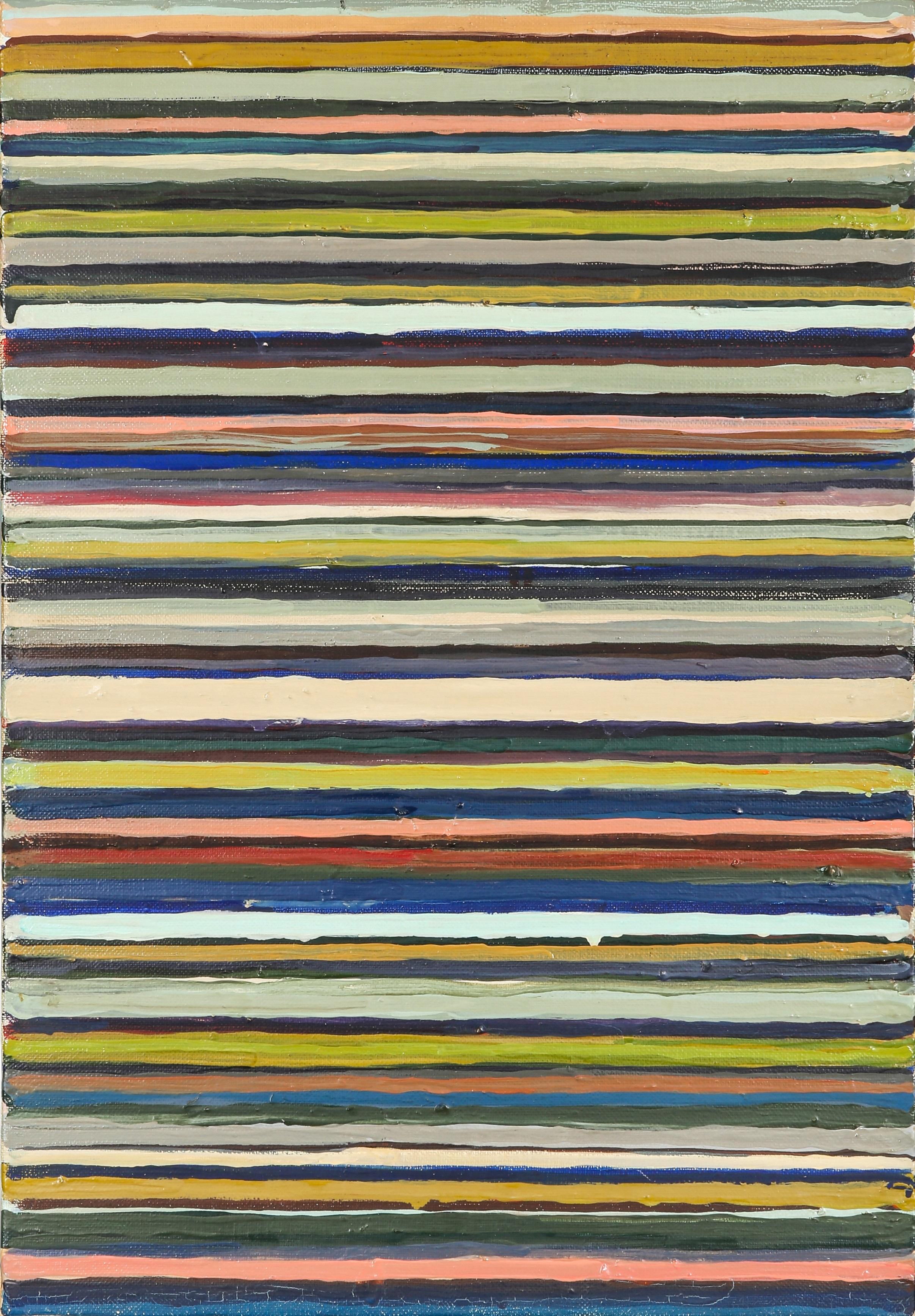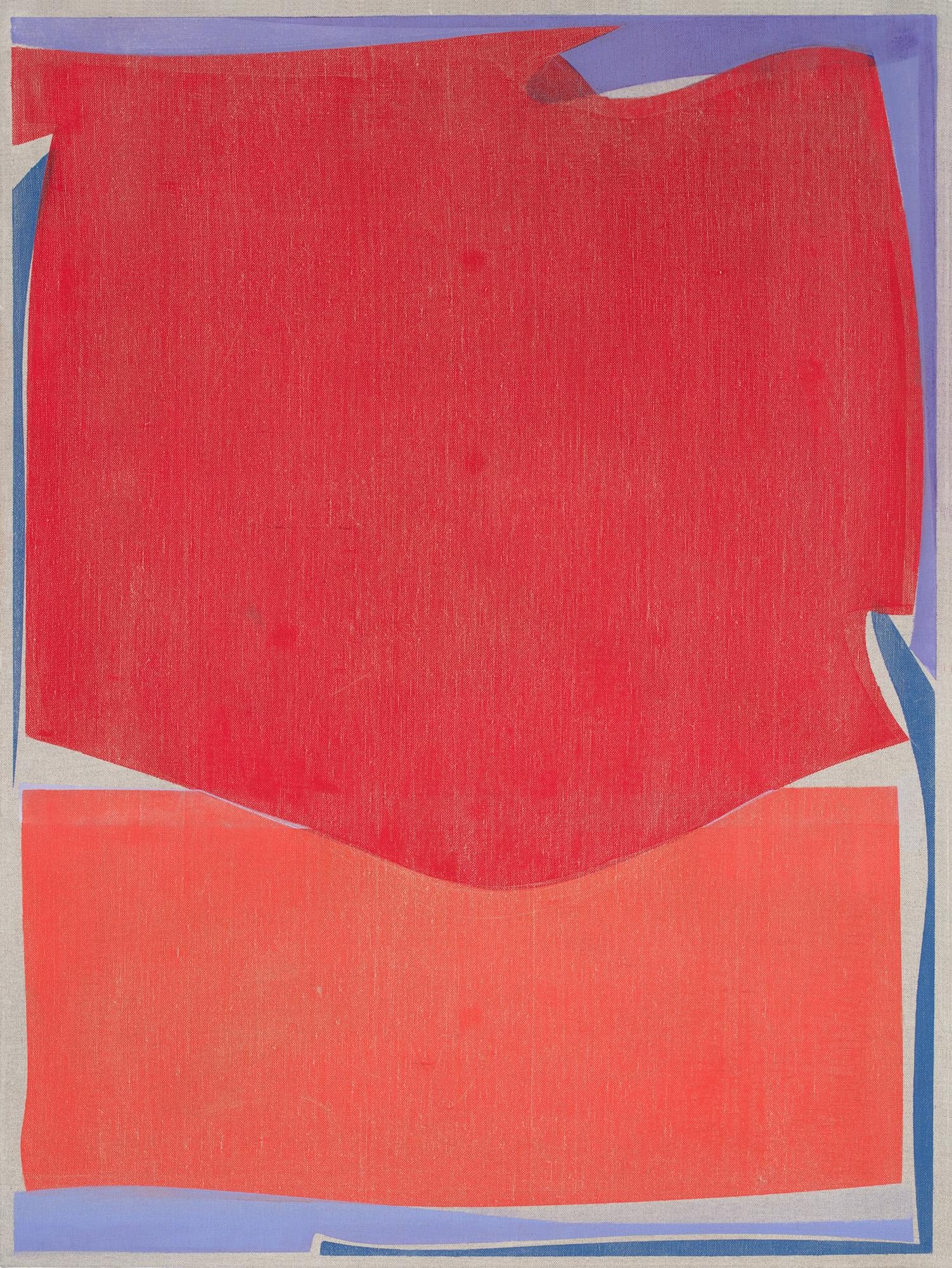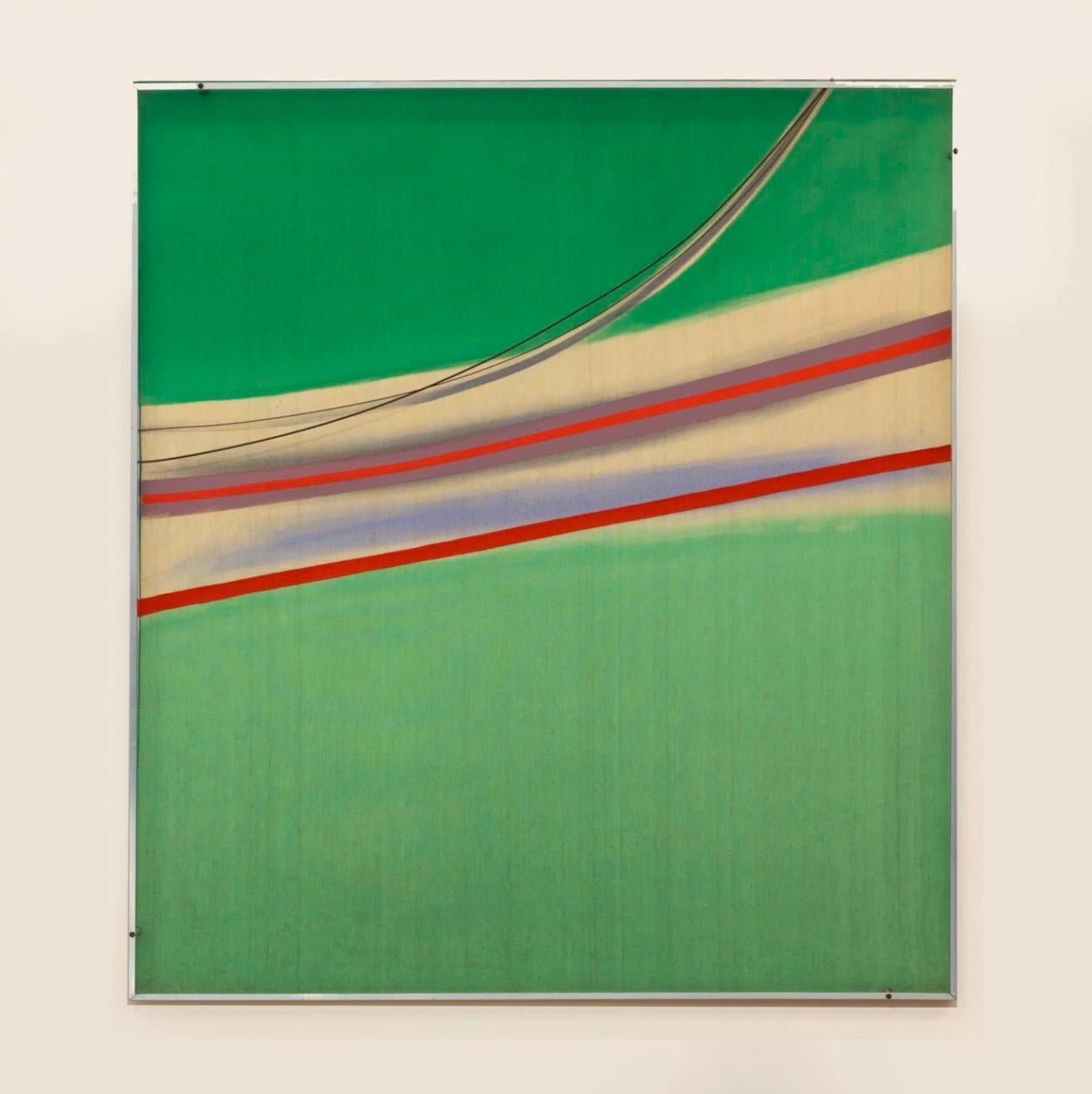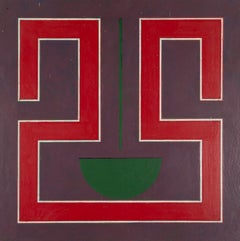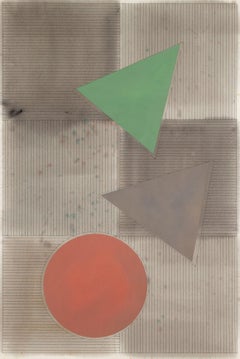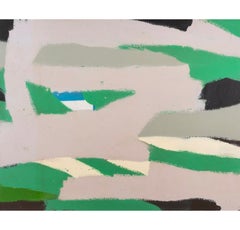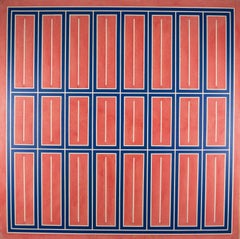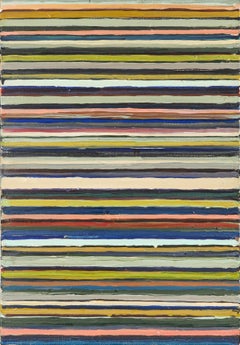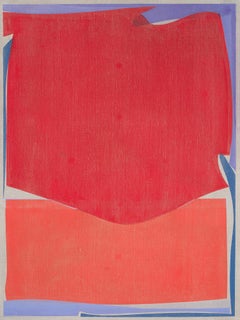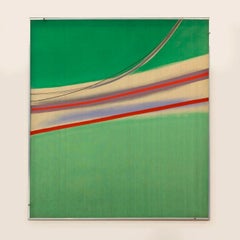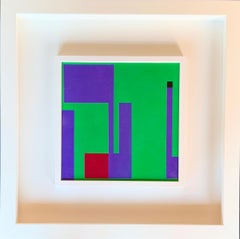Items Similar to L.P. IV (Blue on Red + Green), Oil & Cryla on Board Painting, 1968
Want more images or videos?
Request additional images or videos from the seller
1 of 6
Wilhelmina Barns-GrahamL.P. IV (Blue on Red + Green), Oil & Cryla on Board Painting, 19681968
1968
Price Upon Request
Price Upon Request
Price Upon Request
Price Upon Request
Price Upon Request
Price Upon Request
Price Upon Request
Price Upon Request
Price Upon Request
Price Upon Request
About the Item
L.P. IV (Blue on Red + Green), Oil & Cryla on Board Painting by Wilhelmina Barns-Graham, 1968
Additional information:
Medium: Oil and cryla on board
40.4 x 40.4 cm
15 7/8 x 15 7/8 in
Signed and dated
Further signed, titled, and dated again verso
Also signed, titled and dated on the frame
Wilhelmina Barns-Graham was closely associated with the St Ives School of artists, key figures in British abstraction and the history of twentieth-century art.
Barns-Graham was born in St Andrews, Fife, to an old landed Stirlingshire family with traditional values. Wilhelmina, known to her friends as Willie, showed a strong creative ability from very early on in her childhood. While in her senior year of St Hilda’s School, Edinburgh, Barns-Graham negotiated the support of her an aunt in her creative pursuit, against the original wishes of her father. She was accepted onto the Painting Diploma at Edinburgh College of Art in 1931.
Barns-Graham was awarded a scholarship in June 1935, with further awards in each of the following five years. This allowed her to keep a studio and continue her studies at the College until 1939. The time was needed as she suffered many setbacks from severe illness, only graduating in 1937. She and her friends, such as William Gear and Margaret Mellis, were acquainted with contemporary developments in London and Paris having visited throughout the 1930s. Though there was another route to be explored. The long-standing Principal of the College, Hubert Wellington, was aware that some of the most advanced talents in Britain had gathered at St Ives in Cornwall to escape the destruction of War. The situation on the continent and Barns-Graham’s poor health suggested to Wellington that this would be a good locale for her, and she arrived in St Ives in March 1940.
The artist occupied a space next to Ben Nicholson and Barbara Hepworth, at No.3 Porthmeor Studios. Though she continued to exhibit at the Summer Exhibitions of the RSA until 1945, Barns-Graham became more involved in the artistic hub that was St Ives. She became acquainted with the ‘primitive’ Alfred Wallis and the autodidakt Sven Berlin. Barns-Graham’s concerns with precise drawing and ordering of shapes and colour were confirmed by these experiences. Through Margaret Mellis and her husband, Adrian Stokes, who were already in the town, she was early introduced to Nicholson, Hepworth and Naum Gabo, the leaders of the modern movement. In 1942 she became a member of the Newlyn and St Ives Societies of Artists, then in 1949 was a founder member of the Penwith Society, along with other artists such as Berlin, Hepworth, Peter Lanyon, Bernard Leach, Denis Mitchell, Nicholson and John Wells.
One visitor to St Ives in 1947 was the aspiring young poet, David Lewis. He met Barns-Graham and despite an age difference of around ten years, the two were married in 1949. The next decade saw the development of Barns-Graham’s development of Modernism. This was generally in-line with that of St Ives School, starting with perception-based abstraction, as in her 'Glacier' paintings of the early '50s, and moving to a free and intensely personal use of the brush. Barns-Graham and her husband travelled widely, meeting contemporaries in Paris and touring Switzerland and Italy. On returning to England in 1956, David Lewis enrolled in the School of Architecture at Leeds. Barns-Graham accompanied him to teach at Leeds School of Art. She did not return for her second lesson, separating from Lewis and moving back South. They were divorced in 1963.
In 1960 Barns-Graham inherited from her aunt, Mary Neish, a family house, Balmungo, near St Andrews, initiating a new phase in her life. She now began to divide her time between St Ives and St Andrews. For the time being the result was loss of recognition in St Ives with a questionable gain in Scotland or in London. Her work did not falter but it changed direction, now employing hard-edged geometric and linear forms. Her capacity to make them serve the purpose of expression was unique. Never static, her forms are always in motion across the surface. These remained the basis of her work for the next two decades. Barns-Graham was not really short of exposure in the 60s and 70s but felt she had lost the commercial edge to other St Ives painters. The memory of the jockeying for advantage in St Ives remained a bitter one all her life. This seemed to be confirmed in 1985 when the Tate Gallery organised a large exhibition St Ives 1939 – 64 showing only three works by Barns-Graham against twenty, for example, by Roger Hilton. However, the event did mark the beginning of a revival in her spirits and fortunes, continued by the retrospective in 1989 at the City Art Centre in Edinburgh, and at Penzance.
Barns-Graham's first solo show was with the Redfern Gallery, also exhibiting with Gimpel Fils and Leicester Galleries and was included in shows at the ICA, AIA, Riverside Museum, New York. She received Honorary Doctorates from St Andrews (1992), Plymouth, Exeter and Heriot Watt Universities and, in 2001, was awarded a CBE.
Her paintings can be found in public collections worldwide including the Royal Collection; British Museum; Tate Gallery; V&A Museum; Arts Council of Great Britain; British Council Collection; Government Art Collection, London; Ferens Art Gallery, Hull; Fitzwilliam Museum; Kettle's Yard; Newhall College; King's College, Cambridge; Birmingham City Museum & Art Gallery; Jerwood Gallery, Hastings; Hepworth Wakefield; Pallant House, Chichester; Dundee Museum and Art Gallery; Scottish National Gallery of Modern Art, Edinburgh; Isle of Man Arts Council; Michigan University Museum, USA; New South Wales Art Gallery, Sydney, Australia; and University of Otago, New Zealand. Her work is also included in the Bank of Scotland, NatWest Bank, Deutsche Bank and Baring Brothers Collections. David Bowie also owned a number of paintings and drawings.
- Creator:Wilhelmina Barns-Graham (1912 - 2004)
- Creation Year:1968
- Dimensions:Height: 15.875 in (40.33 cm)Width: 15.875 in (40.33 cm)
- Medium:
- Period:
- Condition:
- Gallery Location:Kingsclere, GB
- Reference Number:1stDibs: LU2718214573012
About the Seller
No Reviews Yet
Vetted Professional Seller
Every seller passes strict standards for authenticity and reliability
Established in 2010
1stDibs seller since 2024
41 sales on 1stDibs
Typical response time: 7 hours
- ShippingRetrieving quote...Shipping from: Kingsclere, United Kingdom
- Return Policy
Authenticity Guarantee
In the unlikely event there’s an issue with an item’s authenticity, contact us within 1 year for a full refund. DetailsMoney-Back Guarantee
If your item is not as described, is damaged in transit, or does not arrive, contact us within 7 days for a full refund. Details24-Hour Cancellation
You have a 24-hour grace period in which to reconsider your purchase, with no questions asked.Vetted Professional Sellers
Our world-class sellers must adhere to strict standards for service and quality, maintaining the integrity of our listings.Price-Match Guarantee
If you find that a seller listed the same item for a lower price elsewhere, we’ll match it.Trusted Global Delivery
Our best-in-class carrier network provides specialized shipping options worldwide, including custom delivery.More From This Seller
View AllRed Forms with Small Green Segment - Bold 1960s Abstract Oil Painting, Sixties
By Gordon House
Located in Kingsclere, GB
Gordon House was born in 1932 in Pontardawe, South Wales. Early exposure to art on trips to the Glynn Vivian Art Gallery as a young boy inspired House towards creative endeavors and at the age of fourteen he was awarded a grant to enter art school which he accepted. From 1947 to 1950 he studied at Luton School of Art, Bedfordshire, and St. Albans School of Art, Hertfordshire. House's contemporaries included Richard Smith and John Plumb with whom he remained close. During the early fifties, after finishing art school, House began work as assistant to the ecclesiastical sculptor Theodore Kern. He also spent time at an advertising studio where he honed his burgeoning skills in typography and graphic design. In 1952 House was offered the position of designer for Imperial Chemical Industries Plastics Division where he stayed until 1959. This was followed by two years spent as graphic designer for the Kynoch Press in London. In 1961 House set out on his own as a self-employed designer and typographer. Initially this was supplemented by part-time teaching at art schools in and around London but by 1964 House was able to devote himself entirely to his design work which freed up valuable time to concentrate on his own artistic output in the studio.
In the late fifties, informed by the new art emerging from America and that of his contemporaries in England, House began to create large-scale abstract works which he was invited to show in 1959 at Dennis Bowen's legendary New Vision Centre in Marble Arch.
House was an active participant in the vibrant London art scene of the sixties, regularly attending lectures, exhibitions and discussions. In 1960 he exhibited in 'Situation' the key abstract exhibition of the decade held at the RBA Galleries. Other participating artists included Robyn Denny, Bernard and Harold Cohen, Gillian Ayres, John Hoyland, Richard Smith and William Turnbull among others. These artists, united by a common admiration for American Abstract Expressionism, were frustrated by the lack of exposure given to large-scale abstract works in commercial galleries so they organised their own exhibition. The name was derived from the participants' idea that an abstract painting that occupied the whole field of vision would involve the spectator in an 'event' or 'situation'. This exhibition was followed by 'New London Situation' in 1961 and a nationwide touring Arts Council presentation in recognition of the significance of the two earlier shows.
In 1961 House began producing his first prints at the Kelpra Studio, run by Chris and Rose Prater, where he made the earliest fine art screenprint ever to be produced in Britain. Artists such as Paolozzi and Hamilton followed in his footsteps and together they started a printmaking revolution in Britain. They cemented the medium of the screenprint in the world of fine art as opposed to the commercial sphere and secured the reputation of Kelpra in the process. Later, together with Cliff White, House set up the White Ink (Ltd.) print studio in London, where he produced etchings and wood engravings on a series of magnificent antique printing presses...
Category
20th Century Abstract Paintings
Materials
Oil, Board
Red/Green, from Study for Larger Tri Motif Series, 1977 - Gouache, Watercolour
By Gordon House
Located in Kingsclere, GB
Gordon House was born in 1932 in Pontardawe, South Wales. Early exposure to art on trips to the Glynn Vivian Art Gallery as a young boy inspired House towards creative endeavors and at the age of fourteen he was awarded a grant to enter art school which he accepted. From 1947 to 1950 he studied at Luton School of Art, Bedfordshire, and St. Albans School of Art, Hertfordshire. House's contemporaries included Richard Smith and John Plumb with whom he remained close. During the early fifties, after finishing art school, House began work as assistant to the ecclesiastical sculptor Theodore Kern. He also spent time at an advertising studio where he honed his burgeoning skills in typography and graphic design. In 1952 House was offered the position of designer for Imperial Chemical Industries Plastics Division where he stayed until 1959. This was followed by two years spent as graphic designer for the Kynoch Press in London. In 1961 House set out on his own as a self-employed designer and typographer. Initially this was supplemented by part-time teaching at art schools in and around London but by 1964 House was able to devote himself entirely to his design work which freed up valuable time to concentrate on his own artistic output in the studio.
In the late fifties, informed by the new art emerging from America and that of his contemporaries in England, House began to create large-scale abstract works which he was invited to show in 1959 at Dennis Bowen's legendary New Vision Centre in Marble Arch.
House was an active participant in the vibrant London art scene of the sixties, regularly attending lectures, exhibitions and discussions. In 1960 he exhibited in 'Situation' the key abstract exhibition of the decade held at the RBA Galleries. Other participating artists included Robyn Denny, Bernard and Harold Cohen, Gillian Ayres, John Hoyland, Richard Smith and William Turnbull among others. These artists, united by a common admiration for American Abstract Expressionism, were frustrated by the lack of exposure given to large-scale abstract works in commercial galleries so they organised their own exhibition. The name was derived from the participants' idea that an abstract painting that occupied the whole field of vision would involve the spectator in an 'event' or 'situation'. This exhibition was followed by 'New London Situation' in 1961 and a nationwide touring Arts Council presentation in recognition of the significance of the two earlier shows.
In 1961 House began producing his first prints at the Kelpra Studio, run by Chris and Rose Prater, where he made the earliest fine art screenprint ever to be produced in Britain. Artists such as Paolozzi and Hamilton followed in his footsteps and together they started a printmaking revolution in Britain. They cemented the medium of the screenprint in the world of fine art as opposed to the commercial sphere and secured the reputation of Kelpra in the process. Later, together with Cliff White, House set up the White Ink (Ltd.) print studio in London, where he produced etchings and wood engravings on a series of magnificent antique printing presses...
Category
20th Century Abstract Paintings
Materials
Ink, Watercolor, Gouache
Untitled 01 (Blue Through), Oil on Board Painting by Barry Daniels, 1960s
By Barry Daniels
Located in Kingsclere, GB
Untitled 01 (Blue Through), Oil on Board Painting by Barry Daniels, 1960s
Additional information:
Medium: Enamel paint on board
70 x 89 cm
27 1/2 x 35 in
Barry Daniels was a member...
Category
20th Century Abstract Paintings
Materials
Board
Mitred Matrix (Red), 1968 - Bold 1960s Abstract Oil Painting, Geometric Forms
By Gordon House
Located in Kingsclere, GB
Gordon House 1932-2004
Mitred Matrix (Red), 1968
oil on canvas
152.5 x 152.5 cm
60 x 60 in
unsigned, though from the Estate of the Artist
Gordon House was born in 1932 in Pontardaw...
Category
20th Century Abstract Paintings
Materials
Canvas, Oil
Blue/Red Ornament Frieze II, 1976-77 - Large Bold, Bright Abstract Painting
By Gordon House
Located in Kingsclere, GB
Gordon House 1932-2004
Blue/Red Ornament Frieze II, 1976-1977
with Artist's label attached to the stretcher bar
acrylic on canvas
91 x 91 cm
35 7/8 x 35 7/8 in
Gordon House was born in 1932 in Pontardawe, South Wales. Early exposure to art on trips to the Glynn Vivian Art Gallery as a young boy inspired House towards creative endeavors and at the age of fourteen he was awarded a grant to enter art school which he accepted. From 1947 to 1950 he studied at Luton School of Art, Bedfordshire, and St. Albans School of Art, Hertfordshire. House's contemporaries included Richard Smith and John Plumb with whom he remained close. During the early fifties, after finishing art school, House began work as assistant to the ecclesiastical sculptor Theodore Kern. He also spent time at an advertising studio where he honed his burgeoning skills in typography and graphic design. In 1952 House was offered the position of designer for Imperial Chemical Industries Plastics Division where he stayed until 1959. This was followed by two years spent as graphic designer for the Kynoch Press in London. In 1961 House set out on his own as a self-employed designer and typographer. Initially this was supplemented by part-time teaching at art schools in and around London but by 1964 House was able to devote himself entirely to his design work which freed up valuable time to concentrate on his own artistic output in the studio.
In the late fifties, informed by the new art emerging from America and that of his contemporaries in England, House began to create large-scale abstract works which he was invited to show in 1959 at Dennis Bowen's legendary New Vision Centre in Marble Arch.
House was an active participant in the vibrant London art scene of the sixties, regularly attending lectures, exhibitions and discussions. In 1960 he exhibited in 'Situation' the key abstract exhibition of the decade held at the RBA Galleries. Other participating artists included Robyn Denny, Bernard and Harold Cohen, Gillian Ayres, John Hoyland, Richard Smith and William Turnbull among others. These artists, united by a common admiration for American Abstract Expressionism, were frustrated by the lack of exposure given to large-scale abstract works in commercial galleries so they organised their own exhibition. The name was derived from the participants' idea that an abstract painting that occupied the whole field of vision would involve the spectator in an 'event' or 'situation'. This exhibition was followed by 'New London Situation' in 1961 and a nationwide touring Arts Council presentation in recognition of the significance of the two earlier shows.
In 1961 House began producing his first prints at the Kelpra Studio, run by Chris and Rose Prater, where he made the earliest fine art screenprint ever to be produced in Britain. Artists such as Paolozzi and Hamilton followed in his footsteps and together they started a printmaking revolution in Britain. They cemented the medium of the screenprint in the world of fine art as opposed to the commercial sphere and secured the reputation of Kelpra in the process. Later, together with Cliff White, House set up the White Ink (Ltd.) print studio in London, where he produced etchings and wood engravings on a series of magnificent antique printing...
Category
20th Century Abstract Geometric Paintings
Materials
Canvas, Acrylic
Symo (Blue/Green), 1967 - Abstract Geometric Lines Screen Print by Richard Allen
By Richard Allen
Located in Kingsclere, GB
Richard Allen was an Abstract artist of the 20th century who worked across painting, graphic and technological media.
Allen was born in Worcester in 1933. Influenced by his fathe...
Category
20th Century Abstract Prints
Materials
Screen
You May Also Like
Work C.87. Oil on canvas by Masaaki Yamada (1961), geometric abstract painting
By Masaaki Yamada
Located in Hong Kong, HK
Masaaki Yamada (1929-2010)
Work C.87
Executed in 1961
Oil on canvas
65.2 x 45.6 cm. (25 5/8 x 17 6/8 in.)
Signed, dated and artist’s seal in Japanese (on the reverse)
Category
1960s Abstract Geometric Abstract Paintings
Materials
Canvas, Oil
Joanne Freeman "Squares and Strokes 40 (red)" Oil on Linen
By Joanne Freeman
Located in New York, NY
My paintings and drawings incorporate elements found in architecture, design, popular culture and art history. My reductive compositions and pure color mimic the low-tech graphics ut...
Category
2010s Abstract Abstract Paintings
Materials
Linen, Oil
Green Projection, 1971 - Acrylic on Canvas, British Abstraction - Sandra Blow
By Sandra Blow
Located in London, GB
Green Projection, 1971 - Work on Paper, British Abstraction - Sandra Blow
Signed and dated on canvas overlap on reverse
Acrylic on canvas, with aluminium construction
54 x 48 inches
...
Category
Late 20th Century Abstract Abstract Paintings
Materials
Paper, Acrylic
Bruno Munari (1907-1998) - Oil on wood panel - 1951
By Bruno Munari
Located in Varese, IT
Oil on wood panel, 1951.
Unique work, titled and hand-signed in felt pencil by artist on the verso.
Work size: 30 x 30 cm
Framed size: 58 x 58 cm
Very good conditions, with deep bri...
Category
1950s Abstract Geometric Abstract Paintings
Materials
Wood Panel
Mid-Century Modern Framed Vintage Abstract Geometric Monotype, Gray, Blue, Red
Located in Denver, CO
This Mid-Century Modern abstract monotype by Wilma Fiori (1929-2019) features vibrant red, green, and blue rectangles set against a subtle gray background, creating a striking geomet...
Category
Late 20th Century Abstract Abstract Prints
Materials
Monotype
Blue, Red, and Green Abstract Expressionist Painting with Geometric Elements
Located in Houston, TX
Colorful abstract painting by Corpus Christi, TX artist John Calaway. The piece depicts a color-field of blue, green, red, and yellow with a bright blue circle at the bottom left side. White strokes over the canvas are also noticeable, creating a harmonizing contrast between all the bright colors. Signed by the artist at the bottom right corner. Framed in a gray-washed natural floating frame.
Dimensions Without Frame: H 54 in. x W 69 in.
Artist Statement: Calaway approaches his art with the same kind of driven curiosity that had him excel in new computer technology...
Category
20th Century Abstract Expressionist Abstract Paintings
Materials
Linen, Oil
More Ways To Browse
Barn Paintings
Barn Oil Painting
Oil Paintings Of Barns
Modern Barn Art
Vintage Barn Signs
Vintage Barn Paintings
Old Barn Painting
Red Barn
King David Painting
Bernard City Paintings
St Ives Vintage
L Watts
Original Oil Painting Of Barns
Red Barn Painting
Paintings Of Red Barns
Wellington Painting
Oil Paintings New Zealand
Very Large Scottish Painting
